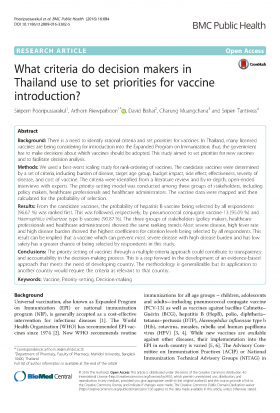This website uses cookies so that we can provide you with the best user experience possible. Cookie information is stored in your browser and performs functions such as recognising you when you return to our website and helping our team to understand which sections of the website you find most interesting and useful.
What criteria do decision makers in Thailand use to set priorities for vaccine introduction? (2016)

รายละเอียดเพิ่มเติม
Siriporn Pooripussarakul1, Arthorn Riewpaiboon1* , David Bishai2, Charung Muangchana3 and Sripen Tantivess4
Abstract
Background: There is a need to identify rational criteria and set priorities for vaccines. In Thailand, many licensed vaccines are being considering for introduction into the Expanded Program on Immunization; thus, the government has to make decisions about which vaccines should be adopted. This study aimed to set priorities for new vaccines and to facilitate decision analysis.
Methods: We used a best-worst scaling study for rank-ordering of vaccines. The candidate vaccines were determined by a set of criteria, including burden of disease, target age group, budget impact, side effect, effectiveness, severity of disease, and cost of vaccine. The criteria were identified from a literature review and by in-depth, open-ended interviews with experts. The priority-setting model was conducted among three groups of stakeholders, including policy makers, healthcare professionals and healthcare administrators. The vaccine data were mapped and then
calculated for the probability of selection.
Results: From the candidate vaccines, the probability of hepatitis B vaccine being selected by all respondents (96.67 %) was ranked first. This was followed, respectively, by pneumococcal conjugate vaccine-13 (95.09 %) and Haemophilus influenzae type b vaccine (90.87 %). The three groups of stakeholders (policy makers, healthcare professionals and healthcare administrators) showed the same ranking trends. Most severe disease, high fever rate and high disease burden showed the highest coefficients for criterion levels being selected by all respondents. This
result can be implied that a vaccine which can prevent most severe disease with high disease burden and has low safety has a greater chance of being selected by respondents in this study.
Conclusions: The priority setting of vaccines through a multiple-criteria approach could contribute to transparency and accountability in the decision-making process. This is a step forward in the development of an evidence-based approach that meets the need of developing country. The methodology is generalizable but its application to another country would require the criteria as relevant to that country.
Full Text: https://bmcpublichealth.biomedcentral.com/articles/10.1186/s12889-016-3382-5




